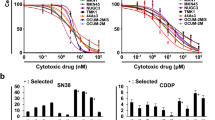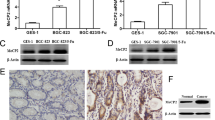Abstract
Purpose
During tumorigenesis, tumor suppressor and tumor-related genes are commonly silenced by aberrant DNA methylation in their promoter regions, which is one of the important determinants of susceptibility to 5-fluorouracil (5-FU) in oral squamous cell carcinoma (OSCC) cells. Here, we examine the chemotherapeutic efficacy of epigenetic agents on 5-FU cytotoxicity.
Method
We investigated the effect of a DNA methyltransferase (DNMT) inhibitor, zebularine (Zeb), on the chemosensitivity of 5-FU and cisplatin (CDDP) by MTT and TUNEL methods, and compared the molecular mechanism of action with those of a GSK3β inhibitor, LiCl, and an Hsp90 inhibitor, 17-AAG.
Results
A significant apoptotic effect by a combination of Zeb or 17-AAG was found in CDDP treatment; however, considerable suppression of 5-FU-induced apoptosis was observed after incubation with Zeb, 17-AAG, or LiCl. Zeb’s suppressive effects were associated with activation of the cAMP/PKA/CREB pathway, differing from mechanisms of 17-AAG and LiCl. Suppression of 5-FU-induced apoptosis by Zeb was not associated with increased Bcl-2 and Bcl-xL expressions dependent on transcription factor CREB, and with the expression level of thymidylate synthase.
Conclusions
In the present study, we identified a more detailed mechanism of action by which Zeb suppresses 5-FU-induced apoptosis. These results indicate that combination therapies have to be carefully investigated due to potential harmful effects in the clinical application of DNMT inhibitors.







Similar content being viewed by others
References
Wrangle JM, Khuri FR (2007) Chemoprevention of squamous cell carcinoma of the head and neck. Curr Opin Oncol 19:180–187
Hsu S, Singh B, Schuster G (2004) Induction of apoptosis in oral cancer cells: agents and mechanisms for potential therapy and prevention. Oral Oncol 40:461–473
Ha PK, Califano JA (2006) Promoter methylation and inactivation of tumour-suppressor genes in oral squamous-cell carcinoma. Lancet Oncol 7:77–82
Suzuki M, Shinohara F, Nishimura K, Echigo S, Rikiishi H (2007) Epigenetic regulation of chemosensitivity to 5-fluorouracil and cisplatin by zebularine in oral squamous cell carcinoma. Int J Oncol 31:1449–1456
Caponigro F, Milano A, Basile M, Ionna F, Iaffaioli RV (2006) Recent advances in head and neck cancer therapy: the role of new cytotoxic and molecular-targeted agents. Curr Opin Oncol 18:247–252
Longley DB, Harkin DP, Johnston PG (2003) 5-Fluorouracil: mechanisms of action and clinical strategies. Nat Rev Cancer 3:330–338
Lei XY, Zhong M, Feng LF, Zhu BY, Tang SS, Liao DF (2007) siRNA-mediated Bcl-2 and Bcl-xl gene silencing sensitizes human hepatoblastoma cells to chemotherapeutic drugs. Clin Exp Pharmacol Physiol 34:450–456
Tumber A, Collins LS, Petersen KD, Thougaard A, Christiansen SJ, Dejligbjerg M, Jensen PB, Sehested M, Ritchie JW (2007) The histone deacetylase inhibitor PXD101 synergises with 5-fluorouracil to inhibit colon cancer cell growth in vitro and in vivo. Cancer Chemother Pharmacol 60:275–283
Ehrlich M (2006) Cancer-linked DNA hypomethylation and its relationship to hypermethylation. Curr Top Microbiol Immunol 310:251–274
Hasegawa M, Nelson HH, Peters E, Ringstrom E, Posner M, Kelsey KT (2002) Patterns of gene promoter methylation in squamous cell cancer of the head and neck. Oncogene 21:4231–4236
Sanchez-Cespedes M, Esteller M, Wu L, Nawroz-Danish H, Yoo GH, Koch WM, Jen J, Herman JG, Sidransky D (2000) Gene promoter hypermethylation in tumors and serum of head and neck cancer patients. Cancer Res 60:892–895
Herman JG, Baylin SB (2003) Gene silencing in cancer in association with promoter hypermethylation. N Engl J Med 349:2042–2054
Egger G, Liang G, Aparicio A, Jones PA (2004) Epigenetics in human disease and prospects for epigenetic therapy. Nature 429:457–463
Cheng JC, Matsen CB, Gonzales FA, Ye W, Greer S, Marquez VE, Jones PA, Selker EU (2003) Inhibition of DNA methylation and reactivation of silenced genes by Zebularine. J Natl Cancer Inst 95:399–409
Soengas MS, Capodieci P, Polsky D, Mora J, Esteller M, Opitz-Araya X, McCombie R, Herman JG, Gerald WL, Lazebnik YA, Cordon-Cardo C, Lowe SW (2001) Inactivation of the apoptosis effector Apaf-1 in malignant melanoma. Nature 409:207–211
Pompeia C, Hodge DR, Plass C, Wu YZ, Marquez VE, Kelley JA, Farrar WL (2004) Microarray analysis of epigenetic silencing of gene expression in the KAS-6/1 multiple myeloma cell line. Cancer Res 64:3465–3473
Beurel E, Kornprobst M, Blivet-Van Eggelpoel MJ, Ruiz-Ruiz C, Cadoret A, Capeau J, Desbois-Mouthon C (2004) GSK-3β inhibition by lithium confers resistance to chemotherapy-induced apoptosis through the repression of CD95 (Fas/APO-1) expression. Exp Cell Res 300:354–364
Grivicich I, Regner A, Zanoni C, Correa LP, Jotz GP, Henriques JA, Schwartsmann G, Da Rocha AB (2007) Hsp70 response to 5-fluorouracil treatment in human colon cancer cell lines. Int J Colorectal Dis 22:1201–1208
Boissel JP, Bros M, Schröck A, Gödtel-Armbrust U, Förstermann U (2004) Cyclic AMP-mediated upregulation of the expression of neuronal NO synthase in human A673 neuroepithelioma cells results in a decrease in the level of bioactive NO production: analysis of the signaling mechanisms that are involved. Biochemistry 43:7197–7206
Li X, Friedman AB, Zhu W, Wang L, Boswell S, May RS, Davis LL, Jope RS (2007) Lithium regulates glycogen synthase kinase-3β in human peripheral blood mononuclear cells: implication in the treatment of bipolar disorder. Biol Psychiatry 61:216–222
Aggarwal S, Kim SW, Ryu SH, Chung WC, Koo JS (2008) Growth suppression of lung cancer cells by targeting cyclic AMP response element-binding protein. Cancer Res 68:981–988
Zhang X, Odom DT, Koo SH, Conkright MD, Canettieri G, Best J, Chen H, Jenner R, Herbolsheimer E, Jacobsen E, Kadam S, Ecker JR, Emerson B, Hogenesch JB, Unterman T, Young RA, Montminy M (2005) Genome-wide analysis of cAMP-response element binding protein occupancy, phosphorylation, and target gene activation in human tissues. Proc Natl Acad Sci USA 102:4459–4464
Sugino Y, Misawa A, Inoue J, Kitagawa M, Hosoi H, Sugimoto T, Imoto I, Inazawa J (2007) Epigenetic silencing of prostaglandin E receptor 2 (PTGER2) is associated with progression of neuroblastomas. Oncogene 26:7401–7413
Hoshino T, Tsutsumi S, Tomisato W, Hwang HJ, Tsuchiya T, Mizushima T (2003) Prostaglandin E2 protects gastric mucosal cells from apoptosis via EP2 and EP4 receptor activation. J Biol Chem 278:12752–12758
Leone V, Di Palma A, Ricchi P, Acquaviva F, Giannouli M, Di Prisco AM, Iuliano F, Acquaviva AM (2007) PGE2 inhibits apoptosis in human adenocarcinoma Caco-2 cell line through Ras-PI3 K association and cAMP-dependent kinase A activation. Am J Physiol Gastrointest Liver Physiol 293:G673–G681
Rowe MK, Chuang DM (2004) Lithium neuroprotection: molecular mechanisms and clinical implications. Expert Rev Mol Med 6:1–18
Yazlovitskaya EM, Edwards E, Thotala D, Fu A, Osusky KL, Whetsell WO Jr, Boone B, Shinohara ET, Hallahan DE (2006) Lithium treatment prevents neurocognitive deficit resulting from cranial irradiation. Cancer Res 66:11179–11186
Shintani Y, Ohta M, Hirabayashi H, Tanaka H, Iuchi K, Nakagawa K, Maeda H, Kido T, Miyoshi S, Matsuda H (2003) New prognostic indicator for non-small-cell lung cancer, quantitation of thymidylate synthase by realtime reverse transcription polymerase chain reaction. Int J Cancer 104:790–795
Pearl LH, Prodromou C, Workman P (2008) The Hsp90 molecular chaperone: an open and shut case for treatment. Biochem J 410:439–453
Banerji U, Walton M, Raynaud F, Grimshaw R, Kelland L, Valenti M, Judson I, Workman P (2005) Pharmacokinetic-pharmacodynamic relationships for the heat shock protein 90 molecular chaperone inhibitor 17-allylamino, 17-demethoxygeldanamycin in human ovarian cancer xenograft models. Clin Cancer Res 11:7023–7032
Hellebrekers DM, Griffioen AW, Van Engeland M (2007) Dual targeting of epigenetic therapy in cancer. Biochim Biophys Acta 1775:76–91
Viswanathan M, Tsuchida N, Shanmugam G (2003) Promoter hypermethylation profile of tumor-associated genes p16, p15, hMLH1, MGMT and E-cadherin in oral squamous cell carcinoma. Int J Cancer 105:41–46
Shi H, Wei SH, Leu YW, Rahmatpanah F, Liu JC, Yan PS, Nephew KP, Huang TH (2003) Triple analysis of the cancer epigenome: an integrated microarray system for assessing gene expression, DNA methylation, and histone acetylation. Cancer Res 63:2164–2171
Cheng JC, Yoo CB, Weisenberger DJ, Chuang J, Wozniak C, Liang G, Marquez VE, Greer S, Orntoft TF, Thykjaer T, Jones PA (2004) Preferential response of cancer cells to zebularine. Cancer Cell 6:151–158
Shintani S, Nakahara Y, Mihara M, Ueyama Y, Matsumura T (2001) Inactivation of the p14(ARF), p15(INK4B) and p16(INK4A) genes is a frequent event in human oral squamous cell carcinomas. Oral Oncol 37:498–504
Plumb JA, Strathdee G, Sludden J, Kaye SB, Brown R (2000) Reversal of drug resistance in human tumor xenografts by 2′-deoxy-5-azacytidine-induced demethylation of the hMLH1 gene promoter. Cancer Res 60:6039–6044
Chen RZ, Pettersson U, Beard C, Jackson-Grusby L, Jaenisch R (1998) DNA hypomethylation leads to elevated mutation rates. Nature 395:89–93
Acknowledgments
We thank Mr. D. Mrozek for editing the manuscript. This work was supported in part by Grant-in-Aids for Scientific Research (20659309) from the Japan Society for the Promotion of Science and (19791480 and 19791482) from the Ministry of Education, Culture, Sports, Science, and Technology, Japan.
Author information
Authors and Affiliations
Corresponding author
Electronic supplementary material
Below is the link to the electronic supplementary material.
280_2008_833_MOESM1_ESM.tif
Fig. S1 Effects of death ligands on cell growth. HSC-3 and Jurkat cells (as a positive control) were treated with increasing concentrations of a cross-linking antibody to Fas receptor, CH11 (A) or recombinant human TRAIL (B) for 48 h, followed by MTT assay. Results represent the percentages (means ± SE) of cell growth to the untreated control (TIF 1077 kb)
280_2008_833_MOESM2_ESM.tif
Fig. S2 p-CREB activity induced by Zeb/5-FU combination. HSC-3 cells pretreated with Zeb (220 μM) for 48 h, were treated with or without 5-FU (250 μg/ml) for 4 h. Nuclear proteins were extracted, and each sample (5 μg/well) was assayed by ELISA. Results show representative OD450 values of triplicate experiments(TIF 1047 kb)
Rights and permissions
About this article
Cite this article
Suzuki, M., Shinohara, F., Endo, M. et al. Zebularine suppresses the apoptotic potential of 5-fluorouracil via cAMP/PKA/CREB pathway against human oral squamous cell carcinoma cells. Cancer Chemother Pharmacol 64, 223–232 (2009). https://doi.org/10.1007/s00280-008-0833-4
Received:
Accepted:
Published:
Issue Date:
DOI: https://doi.org/10.1007/s00280-008-0833-4




